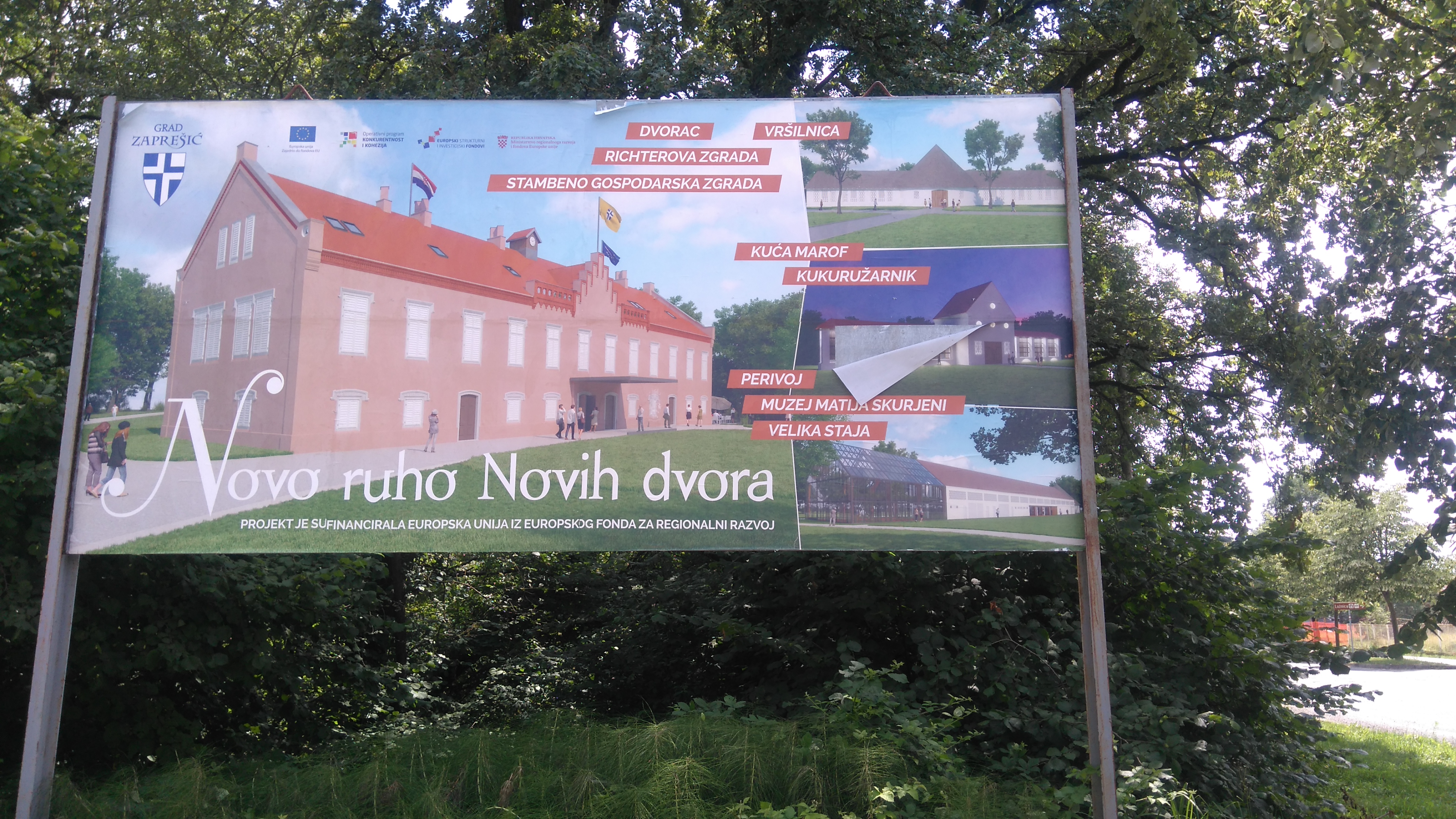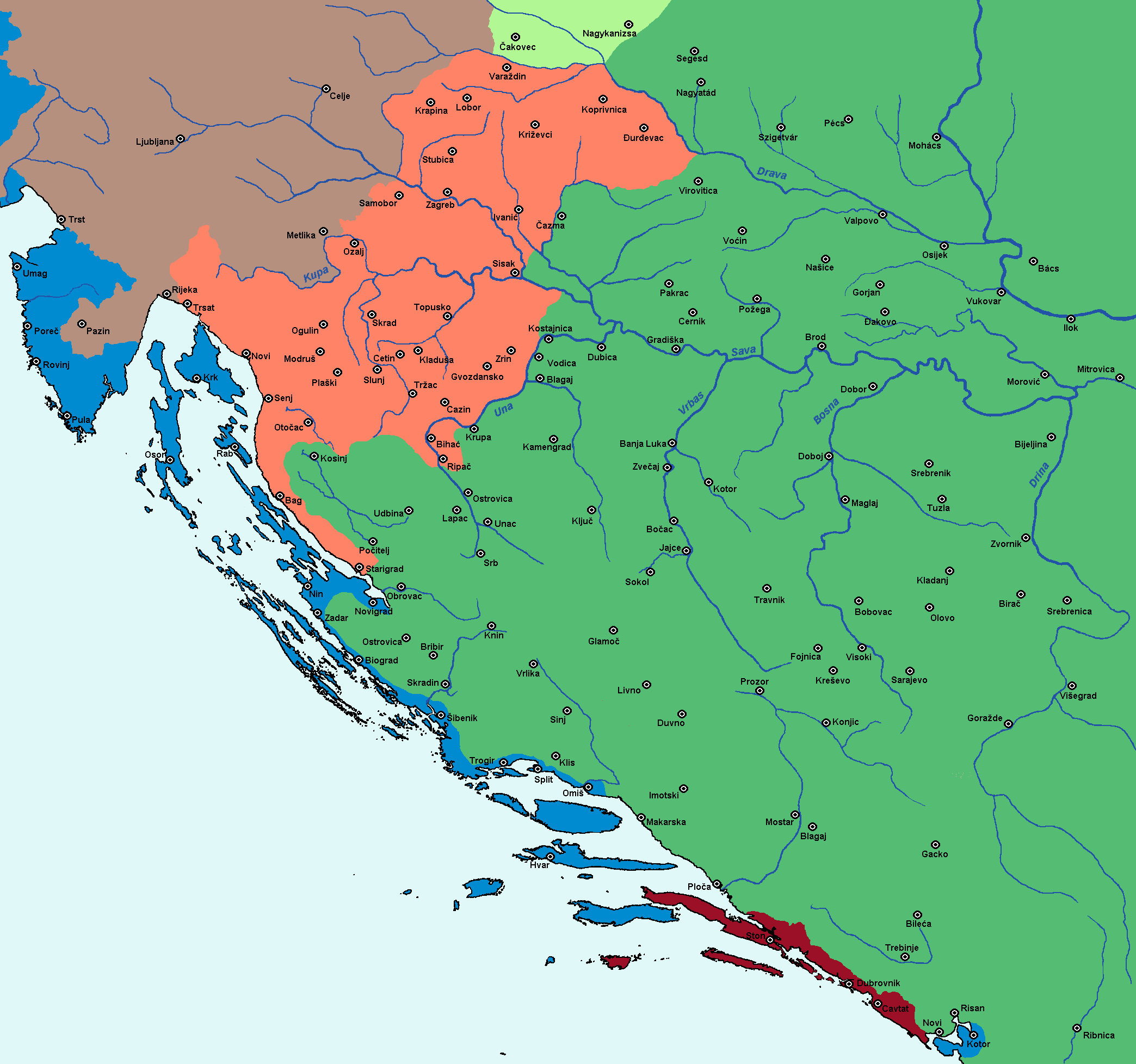|
Susedgrad
Susedgrad Castle ( Hungarian: ''Szomszédvár''), or earlier also only Sused, is a ruined medieval fortress on the far-western hill of mount Medvednica, while also marking the far-western part of modern-day Zagreb, Croatia. Position As written on billboard near Susedgrad ruins, the fortress overwatched an important crossroad at Krapina-Sava confluence, and therefore enabled control over nearby landways and waterways. Archeological and paleontological findings suggest that the place was settled since antiquity. Nearby quarries are also believed to exist since antiquity, supplying stone for building forts and churches in the surrounding area. History Medieval Slavonia Written sources from 1299 and 1287 indicate that the castle was constructed somewhere throughout the second half of 13th century, when it was owned by Cistercian order. It is then mentioned in 1316 in one charter of king Charles I of Hungary as his property. The castle was a royal property until 1345 it was giv ... [...More Info...] [...Related Items...] OR: [Wikipedia] [Google] [Baidu] |
Susedgrad Wars
Susedgrad Castle ( Hungarian: ''Szomszédvár''), or earlier also only Sused, is a ruined medieval fortress on the far-western hill of mount Medvednica, while also marking the far-western part of modern-day Zagreb, Croatia. Position As written on billboard near Susedgrad ruins, the fortress overwatched an important crossroad at Krapina-Sava confluence, and therefore enabled control over nearby landways and waterways. Archeological and paleontological findings suggest that the place was settled since antiquity. Nearby quarries are also believed to exist since antiquity, supplying stone for building forts and churches in the surrounding area. History Medieval Slavonia Written sources from 1299 and 1287 indicate that the castle was constructed somewhere throughout the second half of 13th century, when it was owned by Cistercian order. It is then mentioned in 1316 in one charter of king Charles I of Hungary as his property. The castle was a royal property until 1345 it was giv ... [...More Info...] [...Related Items...] OR: [Wikipedia] [Google] [Baidu] |
Susedgrad-Stubica Seigniory
Susedgrad-Stubica Seigniory was a medieval and early modern feudal estate on what is today Zagreb County, City of Zagreb and Krapina-Zagorje County. Estate borders The estate's western borders spanned from Sutla-Sava confluence, following Sava river towards Strmec Samoborski, Novaki and Rakitje. It then followed Vrapčak creed towards Sava. From there it stretched across mount Medvedniva plains to Poljanica Bistranska and across Gornja Stubica towards Bedekovčina. The estate's northern border spanned from Krapina towards Luka, and northwestwards towards Merenje and Oplaznik, eventually again reaching Sutla river. The estate was centered around two castles – Susedgrad and Stubica. Due to castle Susedgrad's excellent location, the it served as an overwatch of Sava river and road Ljubljana-Sisak. Near Podsused, there was a river crossing point, where local lords charged for crossing the water and controlled the goods entering on the estate. History The estate was formed after ... [...More Info...] [...Related Items...] OR: [Wikipedia] [Google] [Baidu] |
Novi Dvori
Novi Dvori of Zaprešić, or Novi Dvori of Jelačić, is a feudal estate in the northwestern part of Zaprešić, Croatia. The estate consists of a castle, an old granary renovated into a museum, a circular threshing machine, a neo-gothic chapel and the Jelačić family tomb. History Estate from 17th to 19th century During the process of disintegration of larger Susedgrad-Stubica seigniory, Novi dvori (Curia Nova), are mentioned as independent entity as early as the beginning of the 17th century. Historian Stjepan Laljak links estate's foundation with abandonment of nearby Susedgrad Castle, also owned by Zrinski, which was once a seat of the Susedgrad seignory but lost its purpose and became abandoned. According to a document dated in 1852, the Novi Dvori manor was first constructed in 1611 as an ordinary one story manor house mostly made of wood. This initial 17th century concept of a manor, consisted of what is today a western part of the building and its shape has been pr ... [...More Info...] [...Related Items...] OR: [Wikipedia] [Google] [Baidu] |
Ferenc Tahy
Ferenc Tahy de Tahvár et Tarkő, (also known as Franjo Tahi, or Tahy in Croatian and as Ferenc Tahi in Slovenian; 1526–1573) was a Hungarian– Croatian nobleman from the Tahy family, which draws its origins from Pilis County. He was known to have held the positions of royal adviser and master of the horse. His cruel treatment of serfs was one of the causes of Croatian–Slovene Peasant Revolt. Family His father János Tahy held the title of Ban of Croatia in 1524, and died when Ferenc was 10 years old. He was married to Jelena, the sister of famous Croatian nobleman and war general Nikola IV Zrinski. His daughter Margareta was married to Péter Erdődy, ban of Croatia from 1556 to 1567. Tahy also had a son named Gábor. Biography Tahy distinguished himself in the wars against the Ottoman Turks, for which he was appointed commander of the royal army in southern Hungary as well as the commander of strongholds in Szigetvár and Kanizsa. After his estates in Slavonia a ... [...More Info...] [...Related Items...] OR: [Wikipedia] [Google] [Baidu] |
Croatian–Slovene Peasant Revolt
The Croatian–Slovene Peasant Revolt ( sl, hrvaško-slovenski kmečki upor, hr, seljačka buna), Gubec's Rebellion ( hr, Gupčeva buna) or Gubec's peasant uprising of 1573 was a large peasant revolt on territory forming modern-day Croatia and Slovenia. The revolt, sparked by cruel treatment of serfs by Baron Ferenc Tahy, ended after 12 days with the defeat of the rebels and bloody retribution by the nobility. Background In the late 16th century, the threat of Ottoman incursions strained the economy of the southern flanks of the Holy Roman Empire, and feudal lords continually increased their demands on the peasantry. In Croatian Zagorje, this was compounded by cruel treatment of peasants by Baron Ferenc Tahy and his disputes with neighbouring barons over land, dating back to 1564, which escalated into armed conflicts. When multiple complaints to the emperor went unheard, the peasants conspired to rebel with their peers in the neighbouring provinces of Styria and Carniola and w ... [...More Info...] [...Related Items...] OR: [Wikipedia] [Google] [Baidu] |
Johann Katzianer
Johann Katzianer ( sl, Ivan Kacijanar), or Hans Katzianer, Freiherr zu Katzenstein und Fledingen (1491, Begunje (german: Vigaun) – 27 October 1539, Hrvatska Kostajnica) was a Carniolan aristocrat and an Imperial Army commander. History He is first mentioned in 1527 when Ferdinand I, Holy Roman Emperor gathered an army to support his claims on the throne of Hungary, which had become vacant after King Louis II of Hungary was killed in the Battle of Mohács (1526) against the Ottomans. Katzianer took part in Ferdinand's Hungarian campaign of 1527–1528 against the voivode of Transylvania, John Zápolya, who had also been proclaimed King, supported by a large faction of the nobility in the Hungarian kingdom. Katzianer distinguished himself in the Battle of Tarcal in September 1527 and especially in the Battle of Szina in March 1528, but alienated himself from the population by the violence and misbehavior of his troops. In 1529 he participated in the Siege of Vienna against S ... [...More Info...] [...Related Items...] OR: [Wikipedia] [Google] [Baidu] |
Zagreb
Zagreb ( , , , ) is the capital (political), capital and List of cities and towns in Croatia#List of cities and towns, largest city of Croatia. It is in the Northern Croatia, northwest of the country, along the Sava river, at the southern slopes of the Medvednica mountain. Zagreb stands near the international border between Croatia and Slovenia at an elevation of approximately above mean sea level, above sea level. At the 2021 census, the city had a population of 767,131. The population of the Zagreb urban agglomeration is 1,071,150, approximately a quarter of the total population of Croatia. Zagreb is a city with a rich history dating from Roman Empire, Roman times. The oldest settlement in the vicinity of the city was the Roman Andautonia, in today's Ščitarjevo. The historical record of the name "Zagreb" dates from 1134, in reference to the foundation of the settlement at Kaptol, Zagreb, Kaptol in 1094. Zagreb became a free royal city in 1242. In 1851 Janko Kamauf became Z ... [...More Info...] [...Related Items...] OR: [Wikipedia] [Google] [Baidu] |
Charles I Of Hungary
Charles I, also known as Charles Robert ( hu, Károly Róbert; hr, Karlo Robert; sk, Karol Róbert; 128816 July 1342) was King of Hungary and Croatia from 1308 to his death. He was a member of the Capetian House of Anjou and the only son of Charles Martel, Prince of Salerno. His father was the eldest son of Charles II of Naples and Mary of Hungary. Mary laid claim to Hungary after her brother, Ladislaus IV of Hungary, died in 1290, but the Hungarian prelates and lords elected her cousin, Andrew III, king. Instead of abandoning her claim to Hungary, she transferred it to her son, Charles Martel, and after his death in 1295, to her grandson, Charles. On the other hand, her husband, Charles II of Naples, made their third son, Robert, heir to the Kingdom of Naples, thus disinheriting Charles. Charles came to the Kingdom of Hungary upon the invitation of an influential Croatian lord, Paul Šubić, in August 1300. Andrew III died on 14 January 1301, and within four mon ... [...More Info...] [...Related Items...] OR: [Wikipedia] [Google] [Baidu] |
Stenjevec
Stenjevec is one of the districts of Zagreb, Croatia. It is located in the western part of the city and has 61 000 inhabitants (as of 2011). List of neighborhoods in Stenjevec * Jankomir * Malešnica * "Matija Gubec" * Stenjevec * Špansko Špansko Oranice. Špansko is a neighbourhood in the western part of Zagreb. It has about 24,000 inhabitants. žpan), but was modified by both Hungarian (''ispan'') and Croatian language (ispan > span > špan). ''Špansko'' is administrative area ... * Vrapče-jug * Šestine References Districts of Zagreb {{ZagrebCity-geo-stub ... [...More Info...] [...Related Items...] OR: [Wikipedia] [Google] [Baidu] |





